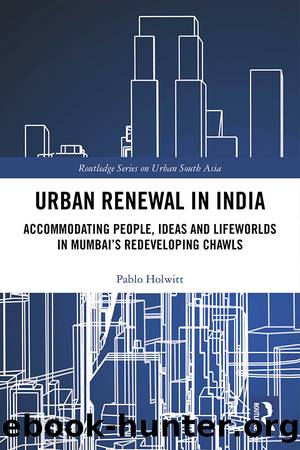Urban Renewal in India by Pablo Holwitt

Author:Pablo Holwitt [Holwitt, Pablo]
Language: eng
Format: epub
ISBN: 9780367345938
Google: sW-VxwEACAAJ
Publisher: Routledge
Published: 2020-01-15T05:00:53+00:00
The discursive presence of buildersâ violence
Apart from the stories about illegal compensation payments and hidden deals between Mr Mishra and members of the former committee mentioned in the preceding section, Andrew, Urmila and Alfonso frequently referred to various other rumours to support their arguments. In this section, as well as in the following one, I will discuss these rumours and what they reveal about the nature of cohabitation in Shanti Towers. I distinguish between two types of rumours: Rumours about the ruthlessness of builders and rumours linking observations of residentsâ consumption and lifestyle choices to accusations of corruption. While the first kind embeds the conflicts encountered in the case of Shanti Towers within larger narratives about redevelopment, the second kind is symptomatic for the contested field of class status in neoliberal India. Both types of rumours contribute to the creation of a climate of suspicion that characterizes life within many redeveloped chawls in Girgaum. I will begin by outlining the nature of rumours about builder violence.
It is a kind of open secret that Mumbaiâs underworld was and is involved in the cityâs highly lucrative real estate market. The lore of Mumbaiâs âdevelopment mafiaâ (Weinstein 2008) influences the imagination of residents and causes anxiety over buildersâ ruthless actions against residents who oppose redevelopment projects. During the late 1990s, when the redevelopment project of Shanti Towers was in full swing, news media covered gangster violence linked to Mumbaiâs urban restructuring programme extensively. Stories about close ties between builders and the criminal underworld also inspired popular films.5 These media narratives were mirrored by rumours about the reckless attitude of builders who would not shy away from using brute force to vacate slums and chawls that were to be redeveloped. This image of builder violence continues to shape residentsâ subjectivities in a subtle, but permeating manner and establishes violence as a continuing presence in the everyday lives of residents. In this climate, rumours and fear feed upon each other. The following passage from my conversation with Andrew illustrates this fear that resulted from the circulation of rumours about Mr Mishraâs ruthlessness.
ANDREW: The people were scared of the developer. See, here in India, to fight against a builder, it was like a trap! In those days, you know, it was happening daily! âSomebody has been shotâ, âthe builder has shot so many people and he has set their buildings on fireâ.â¦
P.H.: So, people got scared.
ANDREW: Yes, scared for their lives! Like, my mom used to never allow me to come out of the house! She wanted me to stay back at home. I used to go downstairs, but she came running after me! She was scared of the builder! She was like, you know, âMy son might lose his lifeâ.
Download
This site does not store any files on its server. We only index and link to content provided by other sites. Please contact the content providers to delete copyright contents if any and email us, we'll remove relevant links or contents immediately.
Kathy Andrews Collection by Kathy Andrews(11345)
The remains of the day by Kazuo Ishiguro(8419)
Paper Towns by Green John(4812)
Spare by Prince Harry The Duke of Sussex(4807)
Industrial Automation from Scratch: A hands-on guide to using sensors, actuators, PLCs, HMIs, and SCADA to automate industrial processes by Olushola Akande(4633)
The Body: A Guide for Occupants by Bill Bryson(4600)
Machine Learning at Scale with H2O by Gregory Keys | David Whiting(3668)
Be in a Treehouse by Pete Nelson(3654)
Harry Potter and the Goblet Of Fire by J.K. Rowling(3620)
Never by Ken Follett(3550)
Goodbye Paradise(3463)
The Remains of the Day by Kazuo Ishiguro(3148)
Into Thin Air by Jon Krakauer(3136)
The Cellar by Natasha Preston(3081)
The Genius of Japanese Carpentry by Azby Brown(3045)
Fairy Tale by Stephen King(2976)
120 Days of Sodom by Marquis de Sade(2947)
Drawing Shortcuts: Developing Quick Drawing Skills Using Today's Technology by Leggitt Jim(2943)
The Man Who Died Twice by Richard Osman(2824)
